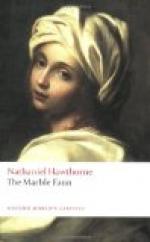“I fear she is not well,” said Hilda. “I am going down the stairs, and will join Miriam.”
“Farewell, then,” said the sculptor. “Dear Hilda, this is a perplexed and troubled world! It soothes me inexpressibly to think of you in your tower, with white doves and white thoughts for your companions, so high above us all, and With the Virgin for your household friend. You know not how far it throws its light, that lamp which you keep burning at her shrine! I passed beneath the tower last night, and the ray cheered me, because you lighted it.”
“It has for me a religious significance,” replied Hilda quietly, “and yet I am no Catholic.”
They parted, and Kenyon made haste along the Via Sistina, in the hope of overtaking the model, whose haunts and character he was anxious to investigate, for Miriam’s sake. He fancied that he saw him a long way in advance, but before he reached the Fountain of the Triton the dusky figure had vanished.
CHAPTER XIII
A SCULPTOR’S STUDIO
About this period, Miriam seems to have been goaded by a weary restlessness that drove her abroad on any errand or none. She went one morning to visit Kenyon in his studio, whither he had invited her to see a new statue, on which he had staked many hopes, and which was now almost completed in the clay. Next to Hilda, the person for whom Miriam felt most affection and confidence was Kenyon; and in all the difficulties that beset her life, it was her impulse to draw near Hilda for feminine sympathy, and the sculptor for brotherly counsel.
Yet it was to little purpose that she approached the edge of the voiceless gulf between herself and them. Standing on the utmost verge of that dark chasm, she might stretch out her hand, and never clasp a hand of theirs; she might strive to call out, “Help, friends! help!” but, as with dreamers when they shout, her voice would perish inaudibly in the remoteness that seemed such a little way. This perception of an infinite, shivering solitude, amid which we cannot come close enough to human beings to be warmed by them, and where they turn to cold, chilly shapes of mist, is one of the most forlorn results of any accident, misfortune, crime, or peculiarity of character, that puts an individual ajar with the world. Very often, as in Miriam’s case, there is an insatiable instinct that demands friendship, love, and intimate communion, but is forced to pine in empty forms; a hunger of the heart, which finds only shadows to feed upon.
Kenyon’s studio was in a cross-street, or, rather, an ugly and dirty little lane, between the Corso and the Via della Ripetta; and though chill, narrow, gloomy, and bordered with tall and shabby structures, the lane was not a whit more disagreeable than nine tenths of the Roman streets. Over the door of one of the houses was a marble tablet, bearing an inscription, to the purport that the sculpture-rooms within had formerly been occupied by the illustrious artist Canova. In these precincts (which Canova’s genius was not quite of a character to render sacred, though it certainly made them interesting) the young American sculptor had now established himself.




